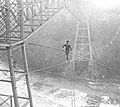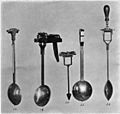Moment of inertia facts for kids

Moment of inertia is a way to measure how much an object resists changes to its spinning motion. Think of it like how mass resists changes to an object's straight-line motion. It's also called "angular mass" and is measured in units like kilograms times meters squared (kg·m2).
When something is spinning, its moment of inertia tells us how hard it is to make it spin faster or slower. The more mass an object has, and the farther that mass is from the center it's spinning around, the larger its moment of inertia will be.
Contents
What is Moment of Inertia?
Imagine you have a merry-go-round. If all the kids are standing close to the center, it's easier to spin it fast. But if they all move to the edge, it becomes much harder to get it spinning quickly. This is because when the kids move to the edge, the merry-go-round's moment of inertia increases.
Moment of inertia depends on two main things:
- How much mass an object has.
- How that mass is spread out around the axis (the imaginary line it spins around).
The farther the mass is from the axis of rotation, the greater the moment of inertia. This is why an ice skater spins faster when she pulls her arms in – she's bringing her mass closer to her spinning axis, which reduces her moment of inertia.
Moment of Inertia in Everyday Life
You can see moment of inertia at work all around you:
- Spinning tops: A top keeps spinning because of its moment of inertia. It resists falling over or slowing down.
- Car wheels: The wheels of a car have a moment of inertia. It takes energy to get them spinning, and once they are, they help the car keep moving.
- Flywheels: These are heavy wheels designed to store energy. They have a large moment of inertia, which helps to smooth out the power delivery in engines, like in old tractors.
Moments of Inertia for Different Shapes
Different shapes have different moments of inertia, even if they have the same mass. This is because their mass is distributed differently around their spinning axis. For example, a hollow cylinder (like a pipe) will have a larger moment of inertia than a solid cylinder of the same mass and radius, because more of its mass is farther from the center.
Scientists and engineers use special formulas to calculate the moment of inertia for various shapes. These calculations are important for designing everything from car engines to satellites.
Related topics
- Angular momentum: This is a measure of how much an object is rotating, taking into account its mass, shape, and speed.
- Torque: This is a twisting force that can cause an object to rotate or change its rotation.
Images for kids
-
Tightrope walkers often use a long pole for balance. The pole has a large moment of inertia, which makes it harder for them to tip over quickly. This photo shows Samuel Dixon crossing the Niagara River in 1890.
-
A 1920s John Deere tractor with a large spoked flywheel on its engine. The flywheel's big moment of inertia helps the engine run smoothly.
See also
 In Spanish: Momento de inercia para niños
In Spanish: Momento de inercia para niños







